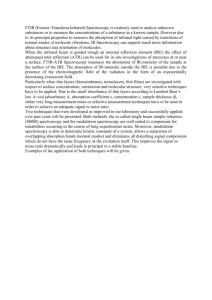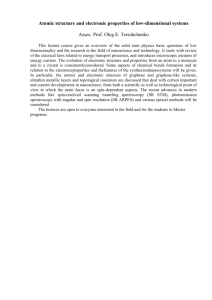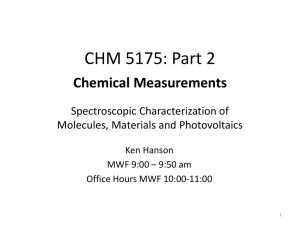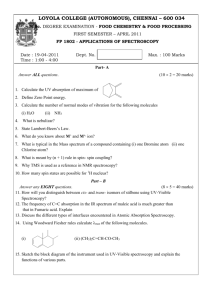Chem. 31 * 9/15 Lecture
advertisement
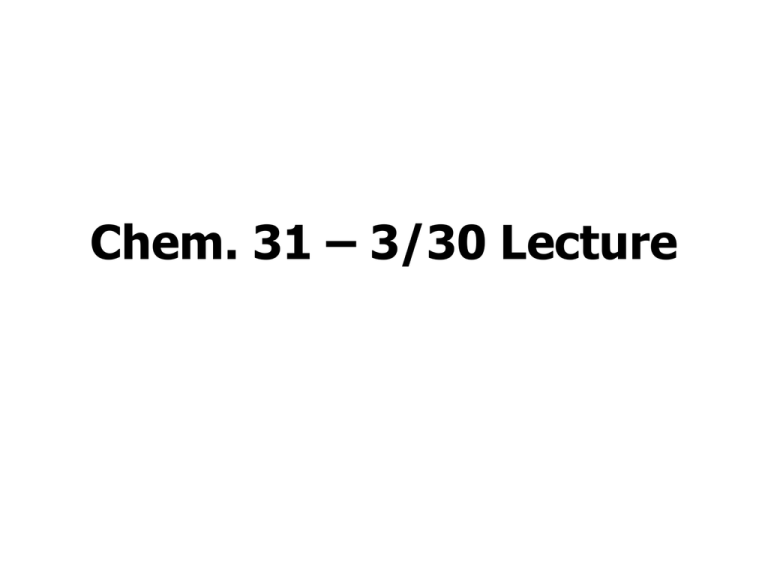
Chem. 31 – 3/30 Lecture Announcements I • Additional Problem due Wed (along with quiz) • No Lab Tomorrow (Campus closed for Cesar Chavez holliday) • Exam 2 – April 13th (2 weeks from today) – Will cover Ch. 6 (parts since Exam 1), Ch. 7, Ch. 17, and part or all (of pages assigned) of Ch. 22 • Homework Set 2 – Set 2.2 problem solutions posted – AP2.2 – needed some minor corrections (see website again for changes) Announcements II • Today’s Lecture – Chapter 7 “Advanced Equilibrium Theory” - The Systematic Method • More Examples • General Comments on the Systematic Method – Chapter 17 Spectroscopy (skipping ahead to keep up with lab) • Introduction • Nature of Light • Absorption of Light/Regions of the Electromagnetic Spectrum The Systematic Method 2nd Example • An aqueous mixture of CdCl2 and NaSCN is made – Initial concentrations are [CdCl2] = 0.0080 M and [NaSCN] = 0.0040 M – Cd2+ reacts with SCN- to form CdSCN+ K = 95 – Got through step 3 last time?? (maybe best to start from step 1 again) The Systematic Method 3rd Example • A student prepares a solution that contains 0.050 mol of AgNO3 and 0.0040 mol NH3 in water with a total volume of 1.00 L. The AgNO3 is totally soluble, NH3 is a weak base, and Ag+ reacts with NH3 to form Ag(NH3)2+. Assume the Ag+ does not react with water or OH-. Go through the first 5 steps of the systematic method. The Systematic Method Stong Acid/Strong Base Problems • When do we need to use the systematic approach? – when more than 1 coupled reaction occur (unless coupling is insignificant) – examples: 4.0 x 10-3 M HCl. 7.2 x 10-3 M NaOH – Key point is the charge balance equation: - for strong acid HX, [H+] = [X-] + [OH-] - If [X-] >> [OH-], then [H+] = [X-] – for strong base NaOH, [H+] + [Na+] = [OH-] The Systematic Method General Comments • Effects of secondary reactions – e.g. MgCO3 dissolution – Additional reactions increase solubility – Secondary reactions also can affect pH (CO32+ H2O will produce OH- while Mg2+ + H2O will produce H+) • Software is also available to solve these types of problems (but still need to know steps 1 → 5 to get problems solved) Chapter 17 - Spectroscopy A. Introduction 1. One of the main branches of analytical chemistry 2. The interaction of light and matter (for purposes of quantitative and qualitative analysis) 3. Topics covered: - Properties of Light - Absorption of Light - Electromagnetic Spectrum - Beer’s Law - Spectrometers Spectroscopy B. Fundamental Properties of Light 1. Wave-like properties: λ λ = wavelength = distance between wave crests n = frequency = # wave crests/s n = wave number = # wave crests/length measure c = speed of light (in vacuum) = 3.00 x 108 m/s Relationships: c = λ·n and n = 1/λ note: speed of light depends on medium (slower in water than in vacuum) – not considered here Spectroscopy Fundamental Properties of Light 1. Other wave-like properties - diffraction, interference 2. Particle-like properties a) Idea of photons (individual entities of light) b) Energy of photons E = hn = hc/l Spectroscopy Absorption vs. Emission 1. Absorption - Associated with a transition of matter from lower energy to higher energy A + hn → A* hn = photon A* → A + hn Energy 2. Emission Excited State Photon out - Associated with a transition from high energy to low energy Ground State Photon in Spectroscopy Regions of the Electromagnetic Spectrum Many regions are defined as much by the types of transitions occurring (e.g. outer shell electron) as by the frequency or energy of the transitions Short wavelengths Gamma rays High Energies Outer shell electrons X-rays UV + visible Nuclear Inner shell transitions electrons Bond vibration Infrared Nuclear spin Microwaves Molecular rotations Long wavelengths Radio waves Electron spin Low Energies Spectroscopy Some Example Questions 1. 2. 3. A nuclear magnetic resonance (NMR) spectrometer absorbs light at a frequency of 750 MHz. This is in the radio frequency and Hz = s-1. What is the wavelength of this light? An infrared absorption band occurs at a wavenumber of 812 cm-1. What is the wavelength (in mm) and energy (J/photon) of that light? What type of light involves transitions of inner shell electrons?
